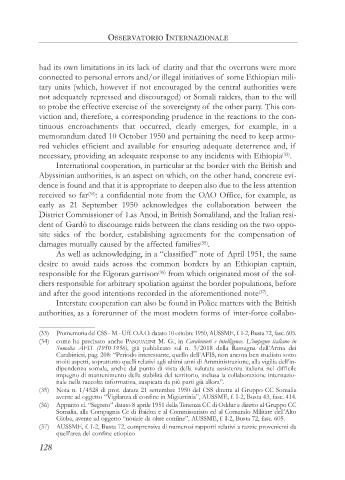Page 130 - Rassegna 2021-4
P. 130
OSSERVATORIO INTERNAZIONALE
had its own limitations in its lack of clarity and that the overruns were more
connected to personal errors and/or illegal initiatives of some Ethiopian mili-
tary units (which, however if not encouraged by the central authorities were
not adequately repressed and discouraged) or Somali raiders, than to the will
to probe the effective exercise of the sovereignty of the other party. This con-
viction and, therefore, a corresponding prudence in the reactions to the con-
tinuous encroachments that occurred, clearly emerges, for example, in a
memorandum dated 10 October 1950 and pertaining the need to keep armo-
red vehicles efficient and available for ensuring adequate deterrence and, if
(33)
necessary, providing an adequate response to any incidents with Ethiopia .
International cooperation, in particular at the border with the British and
Abyssinian authorities, is an aspect on which, on the other hand, concrete evi-
dence is found and that it is appropriate to deepen also due to the less attention
received so far : a confidential note from the OAO Office, for example, as
(34)
early as 21 September 1950 acknowledges the collaboration between the
District Commissioner of Las Anod, in British Somaliland, and the Italian resi-
dent of Gardò to discourage raids between the clans residing on the two oppo-
site sides of the border, establishing agreements for the compensation of
(35)
damages mutually caused by the affected families .
As well as acknowledging, in a “classified” note of April 1951, the same
desire to avoid raids across the common borders by an Ethiopian captain,
(36)
responsible for the Elgoran garrison from which originated most of the sol-
diers responsible for arbitrary spoliation against the border populations, before
(37)
and after the good intentions recorded in the aforementioned note .
Interstate cooperation can also be found in Police matters with the British
authorities, as a forerunner of the most modern forms of inter-force collabo-
(33) Promemoria del CSS - M - Uff. O.A.O. datato 10 ottobre 1950, AUSSME, f. I-2, Busta 72, fasc. 605.
(34) come ha precisato anche PASQUALINI M. G., in Carabinieri e intelligence. L’impegno italiano in
Somalia AFIS (1950-1956), già pubblicato sul n. 3/2018 della Rassegna dell’Arma dei
Carabinieri, pag. 208: “Periodo interessante, quello dell’AFIS, non ancora ben studiato sotto
molti aspetti, soprattutto quelli relativi agli ultimi anni di Amministrazione, alla vigilia dell’in-
dipendenza somala, anche dal punto di vista della valutata assistenza italiana nel difficile
impegno di mantenimento della stabilità del territorio, inclusa la collaborazione internazio-
nale nella raccolta informativa, auspicata da più parti già allora”.
(35) Nota n. 1/4528 di prot. datata 21 settembre 1950 del CSS diretta al Gruppo CC Somalia
avente ad oggetto “Vigilanza di confine in Migiurtinia”, AUSSME, f. I-2, Busta 43, fasc. 414.
(36) Appunto cl. “Segreto” datato 8 aprile 1951 della Tenenza CC di Oddur e diretto al Gruppo CC
Somalia, alla Compagnia Cc di Baidoa e al Commissariato ed al Comando Militare dell’Alto
Giuba, avente ad oggetto “notizie da oltre confine”, AUSSME, f. I-2, Busta 72, fasc. 605.
(37) AUSSME, f. I-2, Busta 72, comprensiva di numerosi rapporti relativi a razzie provenienti da
quell’area del confine etiopico
128

